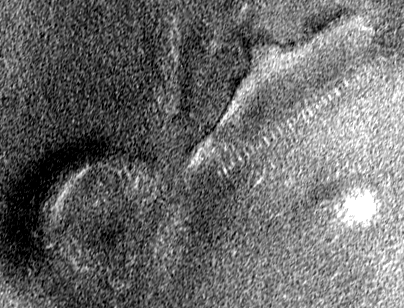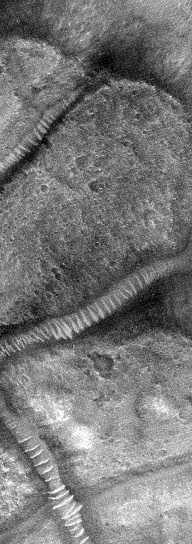Skip to comments.
Life clues on Red Planet
bbcnews.com ^
| may-24-2003
| By Dr David Whitehouse
Posted on 05/24/2003 1:46:37 PM PDT by green team 1999
Life clues on Red Planet
By Dr David Whitehouse BBC News Online science editor
Scientists may have identified what could be the best place to look for life on the Red Planet. It is the Russell Crater in Mars' southern hemisphere.  ............
............
The Russell Crater dunefield,.............Mudflows might occur today
Observations of the region made during the local autumn and spring, when frost covers the dunes and then recedes, indicate liquid water could be present on the surface at certain times of the year.
Detailed analysis suggests this water could be mixing with soil to create frequent mudflows.
"The water we believe is there means that it could be the best place we know of so far where you could dig into the surface to look for life," researcher Dr Dennis Reiss told BBC News Online.
Freeze thaw
"There are extraordinary features in Russell Crater, features resembling terrestrial mudflows," said Dr Reiss, of the German Aerospace Centre.
He has studied high-resolution images from the Mars Global Surveyor spacecraft in orbit around the planet. He has concluded the mudflows could be the youngest features on Mars, perhaps even being formed from time to time during the present day.
In particular, Dr Reiss measured the temperature of the surface along with its reflectivity, technically called its albedo.
These two quantities told him a lot about what is going on in the dunes.
The albedo indicates if the surface is frozen or thawed and the temperature provides clues about what types of ice and liquid are present.
When spring comes
When winter arrives at Russell Crater, water vapour and carbon dioxide condense out of Mars' thin atmosphere and frost the dunes. The albedo and temperature readings indicate that during the spring thaw, the frozen carbon dioxide sublimates - turns into a gas - leaving a thawed surface containing liquid water.
"It could be that in the first couple of centimetres of the surface there is liquid water, possibly even on the surface as well," Dr Reiss said.
"In this place, for a few hours each day, just after noon in the summer, there could be liquid water on the surface of Mars."
Faraway missions
Such a possibility is exciting for those wishing to look for life on the planet.
It is generally believed that to find life on Mars, one should try to find water.
However, none of the spacecraft set for a Mars landing this year are due to go anywhere near the Russell Crater.
The European Beagle 2 will land on the arid plain of Issidis, about 10 degrees north of the equator.
It is a site chosen to be warm enough for Beagle to work and low enough for Beagle's parachutes to allow a safe landing.
The two US rovers, also due for launch next month, will touch down near the equator, halfway around the planet from each other.
Dennis Reiss and Ralf Jaumann publish their work on Russell Crater in Geophysical Research Letters.
for information and discusion only,not for profit etc,etc.
TOPICS: News/Current Events
KEYWORDS: mars; southpole; water
Navigation: use the links below to view more comments.
first previous 1-20, 21-40, 41-60, 61-72 next last
To: RightWhale
There may or may not be life on Mars now, but there will be as soon as we get the program in gear.Well said!
To: RadioAstronomer
That's what happens when you get old. You need to get to the point.
22
posted on
05/24/2003 7:42:15 PM PDT
by
RightWhale
(Theorems link concepts; proofs establish links)
To: ContentiousObjector
assuming for a second that creationism isn't a complete farce and god really did create life, why would he make 9 planets and a ton of other giant cool rocks and only create life on one of them? The other eight (or nine if you count Charon) play critical roles in supporting life on the third planet.
To: RightWhale
at this time mars and the moon are the only options for mankind
To: RightWhale
I agree with you 100% pal!
25
posted on
05/24/2003 7:53:48 PM PDT
by
KevinDavis
(Let the meek inherit the Earth, the rest of us will explore the stars!)
To: green team 1999
mars and the moon are the only options They are both within reach. Relatively easy reach. Achieving either would lift the terrible burden imposed on humanity when the American frontier was officially closed in 1890. It's been a battle since then, from Bellamy's Populists to OBL's alQaida. In the effort to achieve social justice, millions have died, millions and more millions. That is the truth of socialism.
Now, if we can open the frontier, outer space, that is, we can possibly return to the euphoria of Young America. Then we will have a chance to defeat the funk that has enveloped the world for over a century. Otherwise, there appears no end to what we see happening--Orange Alert from now on.
26
posted on
05/24/2003 8:01:09 PM PDT
by
RightWhale
(Theorems link concepts; proofs establish links)
To: green team 1999
Where is Baron Harkonen? The one on the right looks like tunnels left by the giant sand worms of Arrakis. Either that or moose tracks.
27
posted on
05/24/2003 8:03:46 PM PDT
by
Ahban
To: ContentiousObjector
Why indeed? Still, I have looked at this issue a lot and have come to the conclusion that despite the vastness of the cosmos the Earth is too finely tuned.
Intelligent life seems to require such fine tuning that, if it is by chance alone, not only is the galaxy empty of aliens, but we should not even be here!
28
posted on
05/24/2003 8:06:32 PM PDT
by
Ahban
To: Ahban
not only is the galaxy empty of aliens, but we should not even be here! We appear to be alone. This is awesome to contemplate. It also means we have to start acting like groanups.
29
posted on
05/24/2003 8:08:53 PM PDT
by
RightWhale
(Theorems link concepts; proofs establish links)
To: Ahban
The one on the right looks like tunnels left by the giant sand worms of Arrakis. Either that or moose tracks. too many features on mars need to be check,nasa have no answers at this time, and god emperor of mars then would be underground frozen.
To: RightWhale
We appear to be alone.
As large as the universe is, I would think that it may be a bit early to assume that.
This is awesome to contemplate.
I agree, as I find it more difficult to believe that we are the only existing life in the entire universe.
It also means we have to start acting like groanups.
I think it's safe to say, the chances of finding life would probably be greater.
To: Joe Hadenuf
I would think that it may be a bit early to assume that Of course, but that is how it looks.
32
posted on
05/24/2003 8:39:14 PM PDT
by
RightWhale
(Theorems link concepts; proofs establish links)
To: gitmo
Absolutely. Spring Break at the Martian Beach.Ahem.....

To: RightWhale
I know, and I wished that would change. I find being alone with a planet full of people that want to kill each other disturbing.
Did you see the latest images of earth and the moon taken from the spacecraft orbiting Mars? Real neat images.
To: Joe Hadenuf
earth and the moon taken from the spacecraft orbiting Mars? It was surprising that Dr Malin's brainchild has that capability. Perhaps one day we will set up our Dobsonians at a Martian starparty and everyone will peer through the eyepieces at earth with appropriate oohs and aahs .
35
posted on
05/24/2003 8:51:34 PM PDT
by
RightWhale
(Theorems link concepts; proofs establish links)
To: RightWhale
Or even on the lunar surface. The "seeing" must be spectacular......
To: Ahban
To: RightWhale
Thought you would like to see this.
 May 7, 2003 | Astronomers using the Hubble Space Telescope's powerful new Advanced Camera for Surveys (ACS) have taken the deepest visible-light image ever made of the sky. The 3.5-day (84-hour) exposure captures stars as faint as 31st magnitude, according to Tom M. Brown (Space Telescope Science Institute), who headed the eight-person team that took the picture. This is a little more than 1 magnitude (2.5 times) fainter than the epochal Hubble Deep Fields, which were made with the Hubble's Wide Field and Planetary Camera 2. It is 6 billion times fainter than what can be seen with the naked eye.
May 7, 2003 | Astronomers using the Hubble Space Telescope's powerful new Advanced Camera for Surveys (ACS) have taken the deepest visible-light image ever made of the sky. The 3.5-day (84-hour) exposure captures stars as faint as 31st magnitude, according to Tom M. Brown (Space Telescope Science Institute), who headed the eight-person team that took the picture. This is a little more than 1 magnitude (2.5 times) fainter than the epochal Hubble Deep Fields, which were made with the Hubble's Wide Field and Planetary Camera 2. It is 6 billion times fainter than what can be seen with the naked eye.
To: Boiler Plate
The God of the Bible is proclaimed to be omnipotent, omniscient, and omnipresent, with an majesty that is infinitely incomprehensible in its totality. If God exists, and he is such a God, this Self-Existent One, the Eternal I AM, would have no more need to creat 1,000 planets with life than only 1. His glory would not be enhanced or diminished regardless of which number is correct. If such a God chose to create life on other planets, then it exists whether we will ever know it or not. But the evolutionist NEEDS life to exist because, when certain conditions are right, especially the presence of water, and enough time is available, his belief in spontaneous generation makes it virtually inevitable that life will spring from inanimate material again and again.
39
posted on
05/24/2003 9:08:11 PM PDT
by
razorbak
To: Ahban


the glass worms are on different places on mars,miles of it
Navigation: use the links below to view more comments.
first previous 1-20, 21-40, 41-60, 61-72 next last
Disclaimer:
Opinions posted on Free Republic are those of the individual
posters and do not necessarily represent the opinion of Free Republic or its
management. All materials posted herein are protected by copyright law and the
exemption for fair use of copyrighted works.
FreeRepublic.com is powered by software copyright 2000-2008 John Robinson
 ............
............




 May 7, 2003 | Astronomers using the Hubble Space Telescope's powerful new Advanced Camera for Surveys (ACS) have taken the deepest visible-light image ever made of the sky. The 3.5-day (84-hour) exposure captures stars as faint as 31st magnitude, according to Tom M. Brown (Space Telescope Science Institute), who headed the eight-person team that took the picture. This is a little more than 1 magnitude (2.5 times) fainter than the epochal Hubble Deep Fields, which were made with the Hubble's Wide Field and Planetary Camera 2. It is 6 billion times fainter than what can be seen with the naked eye.
May 7, 2003 | Astronomers using the Hubble Space Telescope's powerful new Advanced Camera for Surveys (ACS) have taken the deepest visible-light image ever made of the sky. The 3.5-day (84-hour) exposure captures stars as faint as 31st magnitude, according to Tom M. Brown (Space Telescope Science Institute), who headed the eight-person team that took the picture. This is a little more than 1 magnitude (2.5 times) fainter than the epochal Hubble Deep Fields, which were made with the Hubble's Wide Field and Planetary Camera 2. It is 6 billion times fainter than what can be seen with the naked eye.

